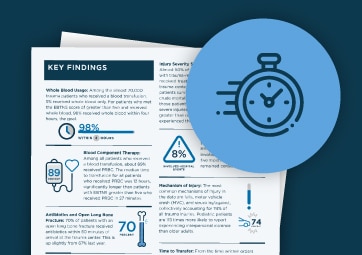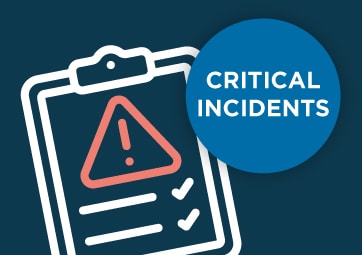When your department gets the call, and it’s time to head out, timing is of the essence, which is why timely arrivals often receive the majority of the spotlight in evaluating incidence response. While it’s true that beating the clock is vital, it’s only one of many factors to consider.
Tracking your department’s data year after year helps you see where you’re doing well and where there’s room to improve. Understanding the types of incidents you handle most often, the areas that need prevention efforts, and ways to protect your firefighters are all steps toward improving your response.
Understanding incident types and trends
Knowing the types of incidents your department responds to most often is a good place to start. The 2024 ESO Fire Service Index shows that:
- 67% of all calls are EMS-related, while 3% are fire-related.
- Among fire-related calls, the top three incident types are:
- Structure fires (36%)
- Natural vegetation fires (21%)
- Outside rubbish fires (21%)
For departments serving wildland-urban interface (WUI) areas, the rise in natural vegetation fires highlights the importance of being ready for these incidents. Community education programs focused on fire-wise practices, such as clearing debris and managing controlled burns, can help reduce risks and prevent fires from starting in the first place.
Safety is more than a priority – it’s essential
Firefighter safety extends beyond the fireground and has long-lasting effects on their health. Research from ESO, based on data from more than 31,000 personnel across 581 agencies, shows that:
- Only 8% of firefighters documented fire-related exposure, but 82% of those performed at least one on-scene decontamination procedure.
- Fewer than 4% documented all recommended best practices, such as using soapy water to clean PPE, wiping exposed areas, and sealing contaminated gear.
These practices are critical in reducing exposure to harmful carcinogens. Studies, including those conducted by the National Institute for Occupational Safety and Health (NIOSH), show that firefighters are at a 9% higher risk of cancer diagnoses and a 14% higher risk of cancer-related deaths compared to the general U.S. population. The longer a firefighter spends on the fireground, the greater their risk.
Learn more about these risks and actionable solutions in the ESO white paper, The Threat That Burns On: Carcinogenic Exposure and the Importance of Decontamination Procedures for Firefighters.
So, what can your department do to improve your response?
Track and improve response times
Your response time is a good place to begin. The 2024 ESO Fire Service Index shows that the median turnout time for fire calls was 1 minute, 12 seconds, which is better than the NFPA benchmark of 1 minute, 20 seconds. The median travel time for fire calls was 4 minutes, meeting the NFPA standard.
To improve further, incorporating a timer with a notification system into your processes can help track turnout times and identify delays. Immediately completing reports once all units are cleared also allows your department to more accurately track data and provide actionable feedback to your crew about performance.
Be prepared for wildland fires
Wildland fire incidents are on the rise, with over 42,000 calls recorded in 2023, according to the 2024 ESO Fire Service Index. Early detection plays an important role in reducing delays, especially in wildland-urban interface (WUI) areas where the combination of vegetation and structures increases fire risks. Collaborating with landowners to install detection systems and investing in foundational training programs like S-130/190 can help crews respond effectively and safely.
WUI environments present unique challenges, requiring careful preparation. Strategies such as creating evacuation plans, identifying staging areas, and conducting controlled burns are essential for limiting the spread of fires. These proactive measures, paired with prevention efforts tailored to WUI-specific risks, can significantly improve outcomes during fire responses.
Focus on firefighter health
Firefighter health is a key priority as departments work to reduce the risks associated with carcinogenic exposure. The ESO Research Roundtable: The Importance of Firefighter Decontamination Procedures is a resource created to help departments start meaningful conversations about improving decontamination practices. Building on insights from ESO’s white paper, The Threat That Burns On, the ESO Research Roundtable offers practical talking points and strategies to address gaps in safety protocols. Departments can use this guide to review current practices, identify areas for improvement, and encourage consistent habits, such as cleaning PPE thoroughly, documenting exposures, and isolating contaminated gear. These steps, supported by structured discussions, can lead to safer outcomes for crews both on and off the fireground.
Better decisions start with better data
Big changes are happening in the fire service industry, and data is at the forefront. On the industry level, the upcoming transition from NFIRS to NERIS as the new emergency reporting standard in the U.S. introduces changes in how data is collected and reported, making it important for departments to have reliable systems in place. On the organizational level, accurate data helps fire departments track performance, improve safety, and adjust to the evolving reporting standards. ESO Fire RMS meets state and national compliance requirements – including NERIS – and supports these efforts by helping departments manage incident reporting, inspections, hydrants, and other operational needs.
Good data is more than numbers – it’s a resource for making informed decisions that improve outcomes for firefighters and the communities they serve. Compiled from 2,269 departments and representing over 6.5 million incidents from January 1 through December 31, 2023, the 2024 ESO Fire Service Index is designed to be used as a baseline to see how your organization aligns nationally across key performance metrics, such as the documentation of decontamination procedures, call response times, most common response types and more. Interested in seeing how your department compares? Read the full 2024 ESO Fire Service Index.



